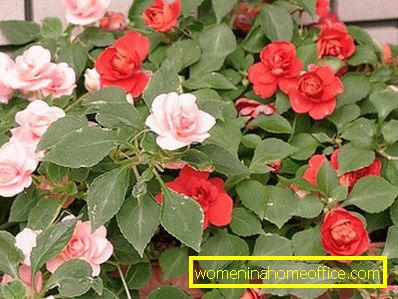Balsamine
The name of the genus of plants to which the Balsams are "impatiens", this word has three meanings in Latin: "impatient", "unable to bear pressure" and "disobeying". And so they called it a bright plant for a reason.
After all, at the slightest touch of its fruit, the boll cracks and throws out seeds. It seems that Balsamine is not eager to give rise to a new life and capture space. By virtue of such a feature, these plants are called “Neglects” and “Jumpers”.
Balsamine as a houseplant grown in Russia for a long time. For the bright flowers he was called "the light". And for the droplets of the liquid that protrudes along the edge of the leaf, - "Wet Roly".
I wonder what is connected with the tradition of giving Balsam human names? For example, in England this plant is called "Busy Lizzie", which means "diligent Lizzy". Apparently, "diligent" for the duration of flowering, but why "Lizzy" - who knows? The Austrians, too, compare the blooming Balsam with a beautiful girl, calling him "The Beautiful Wreath." There is in this plant some special spirituality. And charm!

The variety of species and varieties of balsam
The balsam genus includes about 400 species of both perennial and annual herbaceous plants. Let's get acquainted with the most famous of them.
The most famous is Garden Balsam. For a long time it was this species that single-handedly reigned in the most exquisite flower beds. He has come a long way. The plant from Southern China and India was originally introduced to the culture in America, and only in 1542 brought to Europe.
Garden balsam is a fragile annual plant up to 70 cm in height. Its large, irregularly shaped flowers are located in the leaf sinuses along the branching stem. Differs in flowering duration - from July to the first frosts. Flowers can be simple and terry, differ in a variety of coloring. There are not so many varieties of this species: “Camellia Flowered”, “Tom Thumb” (“Tom Thumb”) and “Baby Bush” (“Baby Bush”).
Balsam Waller is rather popular or - another name - Balsam Waller.
Large flowers of plants of this species are located at the ends of the stems. It is this perennial Balsam that bears the name "Diligent Lizzy" and "Wet Roly".
This type of balsam is now very popular, its new and new varieties and hybrids constantly appear. As a rule, they are combined in a series of colors, height, flower shape.
Modern varieties of the series include up to 17 different shades of red, pink, white, lilac, moreover, there are varieties with a two-tone color. So far there is no yellow and blue Waller Balsamine. But at the rate of selection work with this plant, most likely, only so far.

Here are the most common series of Balsam Waller:
- Not large, with a white spot on the flower: "Stardust" (Stardust), "Frosty" (Frosty).
- Early flowering, compact, with flowers of various colors: "Symphony" (Symphony), "'Super Elfin" (Super Elfin), "Candy" (Candy).
- With terry and semi-double flowers of various colors: "Duet" (Duet), "Fiesta" (Fiesta), "Rosette" (Rosette), "Rose Parade" (Rose Parade), "Carousel" (Carousel).
- A series of varieties with semi-double flowers of all shades of red: "Fansiful Tropical" (Fanciful Tropical)
There are also exotic species of Balzaminov, which, because of their special thermophilicity, are rarely grown in our latitudes.
Balsam balsam - a plant native to the Himalayas, its height reaches 1 meter, but small flowers. Very rare species - its seeds can be purchased only in Europe.
Niamiam Balsam - African exotic, very common in the United States and Europe.
Its flowers have an unusual shape, in outline resembling birds sitting on branches. Coloring of flowers happens pink or red, there are two-color red-yellow grades. Varieties: "Ararad" (Arared), "African Orchids" (African Orchids), "Congo Cockatoo" (Congo Cockatoo), etc.
Balsamic plants in indoor floriculture

Most often, in indoor floriculture, preference is given to any varieties of Balsamine Waller or hybrid Novogviney Balsamine.
Regardless of the type and variety, Balsamine - very unpretentious. With good care, these plants will delight you with their flowers all year round. So let's clarify what conditions can be considered ideal?
- The soil is light, loose, fertile.
- Illumination - best scattered light.
- The air temperature should be around 20-25 ° C in summer and 12-15 ° C in winter. When the temperature drops below 5 ° C, the plant starts to hurt and can die.
- Humidity is not critical. Balsam is resistant to even very dry air. But, nevertheless, when the temperature rises above 25 ° C, it is advisable to spray the plant with warm water.
- Watering - it is necessary to monitor the drying of the top layer of soil. Substrate must be constantly wet. Balsamines love abundant watering, but without the swamp!
- It is advisable to use fertilizers no more than once in 2 weeks. For Balzaminov use mineral complexes for indoor plants, taken at the rate of half of the specified concentration.
- Pruning is necessary, as for all fast-growing plants. In spring, shoots are shortened by half.
- The period of rest at houseplants may be accompanied by flowering. However, it is better still in the autumn and winter to reduce the temperature of the content and reduce watering. If the plant does not bloom, fertilizing is excluded.
- Transplantation is required annually. It should be noted that in 2-3 years Balsamines often lose their attractive neat appearance; in this case, they are better updated by rooting new cuttings.
- Balsamine reproduction. Apical cuttings rooted in water, and then transplanted into the substrate. Looking at the blooming Balsam, it is hard to believe that it is so easy!